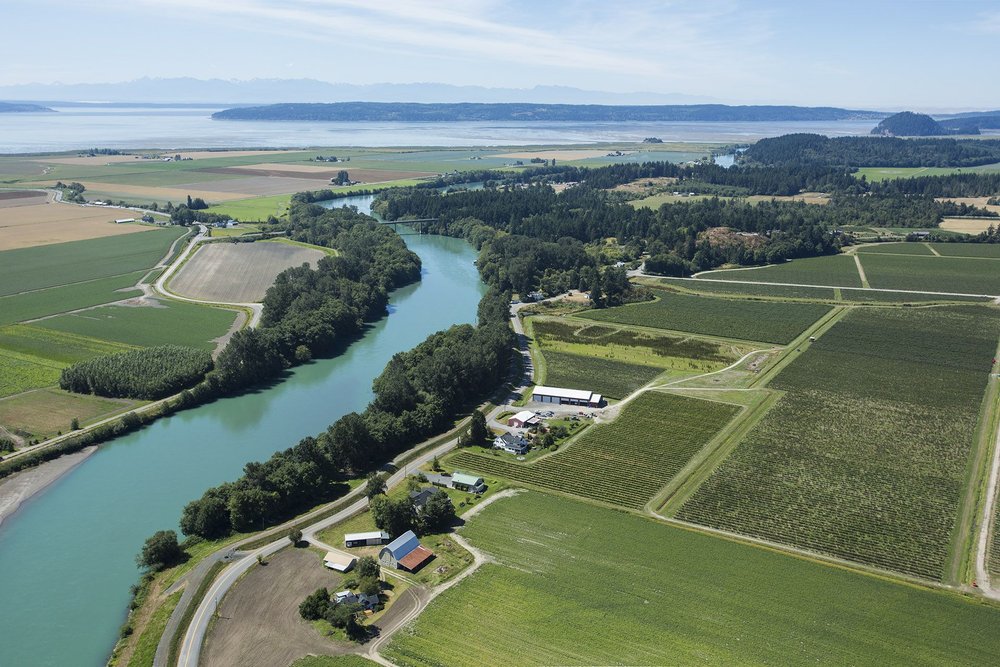It’s hard to imagine a Washington without salmon.
We owe it to ourselves, our neighbors and to future generations to recover salmon populations in Washington. We’re also obligated under the federal Endangered Species Act and through treaties with sovereign tribal nations, not only to make salmon recovery a priority, but to succeed in these efforts.
Governor Inslee has proposed a salmon recovery package that could make a big difference as we work together to ensure salmon have a fighting chance. With a policy proposal for improving habitat and cooling off Washington’s salmon-bearing rivers and streams, a grant program to support habitat restoration and a framework for accountability and adaptive management, the Lorraine Loomis Act (SB 5727/HB 1838) is the linchpin of the Governor’s proposal.
Rivers lined with abundant, healthy vegetation are ideal habitat for salmon. Skagit River photo by Bridget Besaw.
An environmental community priority
The Lorraine Loomis Act is one of four priority bills for the statewide Environmental Priorities Coalition (EPC), a group of more than 20 organizations advocating for a healthier Washington for all.
Named for the late chair of the Northwest Indian Fisheries Commission, and developed through Centennial Accord efforts of treaty tribes and the Governor’s Office, the Lorraine Loomis Act will protect and restore riparian habitat — the trees and plants along riverbanks that are critical to healthy water quality, river shape and temperature for salmon. The bill would require that rivers in priority watersheds are bordered by a band of trees and vegetation wide enough to effectively cool and clean the water. It includes incentives and cost-share provisions to assist landowners, particularly Washington’s farmers, in making needed changes. A $100 million riparian grant program established in the bill is meant to help farmers and other landowners ensure the waterways on the properties they own and manage have the healthy vegetation and cooling shade salmon need to survive. Additional future funding, from state, local, and federal sources, will also be essential to support these stewards of working lands.
Trees and vegetation along the Skagit River help cool down and clean up water filtering through the soil, creating friendlier conditions for salmon. Photo by Marlin Greene/One Earth Images. 
Speak Up for Salmon: send your reps a note
Riparian reforestation reflections
Read a guest essay from a University of Washington graduate student on what she learned about adding trees to riparian areas through a TNC research partnership last summer.
Budget support for innovative water solutions
Another major source of salmon-killing pollution is the stormwater running off our highways, bridges and other paved surfaces. We’re advocating for requests in all three supplemental budgets — operating, capital and transportation — to support innovative, scalable solutions for water.
For instance, the Governor’s salmon recovery proposal supports the launch of a new Community-Based Public-Private Stormwater Partnership Program, which would support collaborations like the one at the foot of Seattle’s Aurora Bridge. The Aurora Bridge Bioswale, completed in 2021, now filters two million gallons of stormwater annually, cleaning out toxicants before they reach Lake Union – and it serves as a model for additional projects across the state. Check out our new video about the project to see why we’re urging the Legislature to create and fund this partnership program.
An innovative public-private partnership is making major progress to clean up polluted stormwater along a busy transportation corridor — and this is just the beginning.
Zeroing in on stormwater pollution hotspots

Click to visit the new Stormwater Heatmap.
There’s no denying the connection between the fate of salmon and the sustainability of our transportation system. The Nature Conservancy’s new stormwater heatmap tool illustrates this link and drives home the need for more creative efforts and public investment – while showing us where we can get the most bang for our buck.
>
“We didn’t set out to map highways. But when you map pollutants, it turns into a highways map.”
Cleaning up polluted stormwater is clearly an urgent imperative – both for recovering salmon populations and for continuing to provide clean drinking water for people in our growing region. As the Legislature considers funding a transportation package for Washington, investments in stormwater retrofits must be included.
President Biden signed the bipartisan Infrastructure Investments and Jobs Act in December 2021.
putting Federal Funds to work
The Infrastructure Investments and Jobs Act that passed late last year included major funding to help salmon recovery efforts, thanks to the efforts of Sen. Maria Cantwell and Rep. Derek Kilmer. The National Culvert Removal, Replacement and Restoration Grant Program – and a billion dollars in funding for it – will help transportation agencies fix fish passage barriers that impact salmon. Governor Inslee’s proposed state funding would help leverage these federal dollars to do more, faster.
Use your voice to speak up for salmon
With an all-virtual legislative session this year, it couldn’t be easier to share your support for salmon recovery with lawmakers. Use the button below to send your senator and representatives a message in support of salmon recovery.
Banner photo: Coho salmon in the Sol Duc River by Adam Baus.
